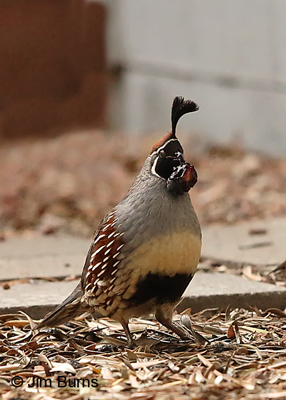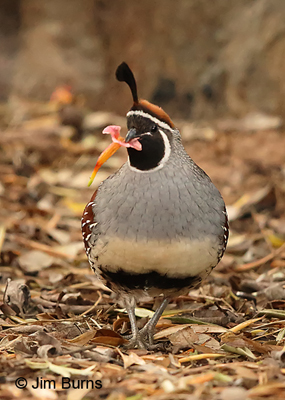|
Gambel's Quail male with Bell's of Fire petal |
Last spring I related how a covey of Gambel’s Quail had taken up residence in our yard, and that we were hopeful this might lead to their nesting with us. Though we found no evidence of that, throughout the summer we often saw chick parades, one time counting 13(!) of the precocial little fuzzball youngsters running up our back alley. I’m now happy to report a covey, perhaps an extended family, has again taken up residence for the winter, their primary overnight roosting site the old Russian Olive tree in our front yard.
Quail feed on the ground, and every birder has seen groups of them walking about through washes and across hillsides, hunting and pecking, but just what is it they’re hunting and pecking? Birders on hands and knees would be hard pressed to discern anything of nutritional value on the desert floor, but our quail seem to have no problem with it. Birds’ eye view, of course, and knowing what works for them. Close observance of their feeding this winter has given us some answers, a few of them unexpected and surprising.
Birds of North America reports Gambel’s are primarily vegetarians, especially in winter when insects, primarily ants, are scarce. Overall 91% of the Gambel’s diet consists of the seeds, leaves, and fruit of forbs, grasses, and cacti. There’s that word “forb” again, which probably resonates only with trained habitat biologists. A forb is any broad-leaved, herbaceous, flowering plant. Forb staples of the quail diet are mesquite, paloverde, acacia, and mistletoe, with the first of these being by far the most consumed. They also readily eat the berries of desert trees and shrubs such a hackberry and wolfberry.
We have cacti and forbs but no grasses, and the forbs we have are not what the Gambel’s research records as favorites. We have three Russian Olives, two Texas Olives, and a palobrea. Initially our Gambel’s seemed to congregate under our two seed feeders, gleaning what was scattered by finches, lovebirds, thrashers and our ever irascible resident Northern Mockingbird. Then a rainy December cold front aborted a planned field trip and gave me an opportunity to observe and record quail activities throughout one afternoon. I discovered they spent the time almost entirely under the Russian Olives with a few forays to the flower beds.
The quail were very selective with the fallen olives, old and desiccated ones were ignored, whole ripe ones inspected then discarded. Apparently they were hunting for ripe ones already broken or sliced open by previous foragers. I assume their bills are not ideal for breaking into tough fruit, but now and again I’d see a male grab a whole olive, then scamper away to a secluded area away from the others and work it with his bill. Petals and leaves were periodically plucked from the Bells of Fire plants, but obviously there is something vitally nutritious for them in the olives. How convenient to have a winter apartment above the grocery store and wake up every morning to the sound of running water as our front fountain sits beneath the front Russian Olive.
